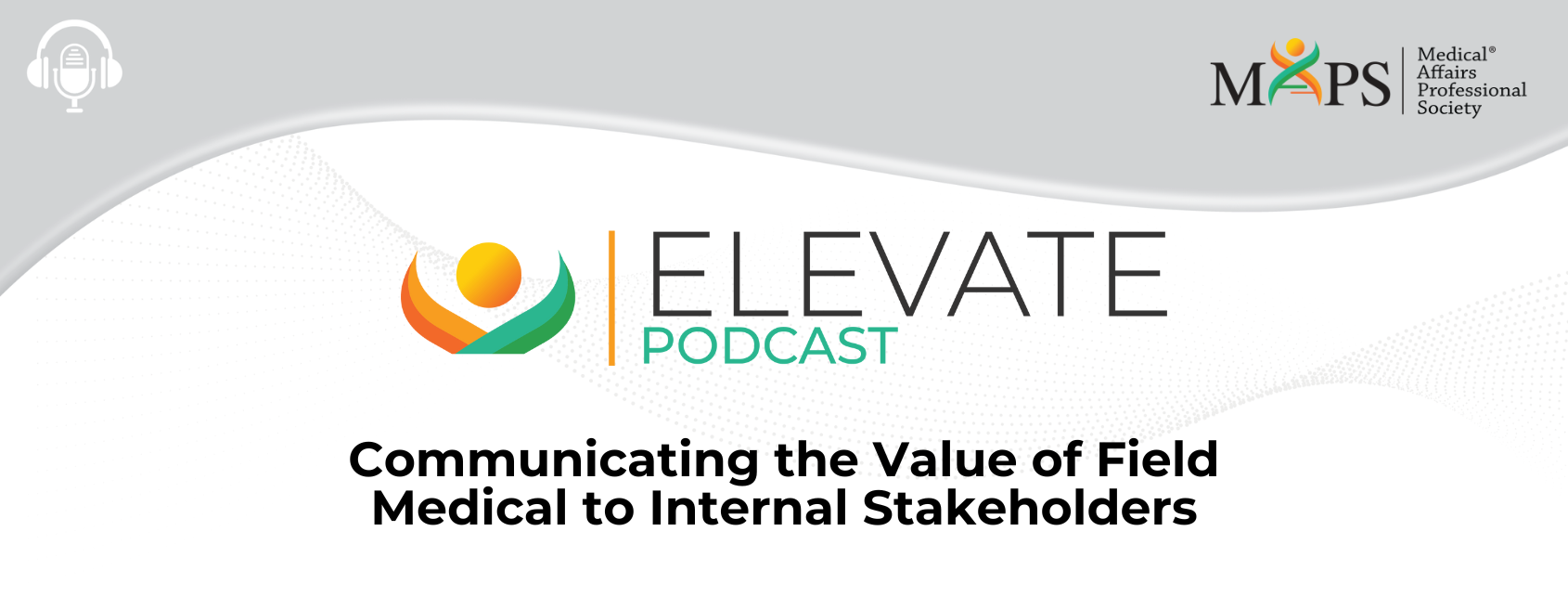Communicating the Value of Field Medical to Internal Stakeholders
Speaker: Nancy Ortiz, PharmD
Speaker: Irma Saliu, PharmD
Welcome to Part 1 of the MAPS Field Medical Focus Area Working Group’s two-part podcast series entitled “Communicating the Value of Field Medical”. In this first episode, experts from the FAWG will discuss Field Medical with the following goals in mind:
- To help the listener communicate the value of Field Medical to internal stakeholders
- Explain how to integrate the qualitative and quantitative measures when communicating Field Medical value to internal stakeholders
- Discuss how to build relationships and engage with internal stakeholders
Following is an automated transcription provided by otter.ai. Please excuse inaccuracies.
Nancy Ortiz 00:00
Welcome to the Medical Affairs Professional Society’s Field Medical Focus Area Working Group’s two part podcast series entitled “Communicating the Value of Field Medical”. In this first podcast we will discuss communicating the value of Field Medical to internal stakeholders. And then the second podcast will focus on communicating the value of Field Medical to external stakeholders. My name is Nancy Ortiz, and I’m a member of the MAPS Field Medical Focus Area Working Group, and I’ll be the moderator for both podcasts. Currently, I am Vice President of Medical Affairs at Prilenia Therapeutics, were a clinical stage biotech company focused on developing novel therapeutics to slow the progression of neurodegenerative diseases, and neurodevelopmental disorders. I’ve spent my 20 plus years in Medical Affairs in a variety of roles, including as an MSL manager and functional leader. Before we begin, I’d like to highlight our legal disclaimer. The views expressed in this recording are those of the individuals and do not necessarily reflect on the opinions of MAPS or the companies with which they are affiliated. This presentation is for informational purposes only, and is not intended as legal or regulatory advice. That said, we encourage you to engage in conversations about fuel metaphor with other MAPS members via MAPS Connect, on the MAPS website or mobile app. You can also visit the MAPS LinkedIn page or MedicalAffairs.org/events to participate in our upcoming webinars and in person conferences. The objectives for this podcast are that at the end, the participant will be able to one communicate the value of Field Medical to internal stakeholders, to be able to integrate the qualitative and quantitative measures when communicating Field Medical value to internal stakeholders. And three, learn how to build relationships and engage with internal stakeholders. I’d like to thank today’s speaker for sharing her subject matter expertise with the MAPS membership. Speaking today is Irma Saliu. She’s National Director of Psychiatry MSLs for US Field Medical Affairs at Abbvie. Pharma. Welcome to the podcast. Before we begin, can you tell us a little bit about yourself?
Irma Saliu 02:30
Sure. Hi, Nancy. Such a pleasure to be here with you today. So as you mentioned, I currently serve as the National Director for the US Psychiatry Medical Science Liaison Team at Abbvie. And prior to this role, I was leading the US CNS team and Allergan so I’ve been in the industry for about a decade now spending most of my career in Medical Affairs, specifically in Field Medical, so you could say I’m super passionate about this field. And in terms of training, I’m a PharmD.
Nancy Ortiz 03:01
That’s fantastic. Well, again, thank you Irma, and we are thrilled to have you join us. So let’s kick off the discussion. So we know that Field Medical is is a key function within any Medical Affairs organization. But as we all know, it may be difficult to translate metrics and insights gathered by MSL to showcase the value that this very important function brings to the organization. How do you communicate the value of Field Medical to internal stakeholders? Can you share with us some what are some perspectives that you consider?
Irma Saliu 03:41
Sure, and yes, you are correct, Nancy, Field Medical is certainly a key function in any organization. And although we tend to measure part of this function success, right through objective measures, particularly through metrics, such as number of engagements with key external experts, I think it is often difficult for field leaders to communicate the full value proposition that Field Medical as a function can bring to internal stakeholders. So from my perspective, first I think it’s important to know your audience of internal stakeholders you’re communicating and working with approaching building relationships with internal stakeholders, I think it should be quite similar to those that we approach when engaging and networking with key external stakeholders. Right. And I think this is especially important and critical skill that we all hold so close and dear to us, you know, as this function, what makes us successful in the field so I think it is important for us to remember to continue to leverage this skill internally as well. But as you know, right building relationships take certain time effort, a lot of preparation But ultimately, as a field leader of this organization, your goal as a leader is to showcase your team’s capabilities and level of impact to the organization. Additionally, I think understanding each internal stakeholders preferred method of communication is very important. So I’ll give you an example. I think it’s important to spend some time understanding what internal stakeholders expectations are, but also the level of detail they need from you, as a leader of a Field Medical team, I think all of this will ensure that you are aligned from the start and being able to have a productive collaboration. So I guess in summary, before we even begin showcasing the value of Field Medical as an organization, and its impact, I think it’s important that we first spend some time building relationships, internally, effectively networking with key internal stakeholders, understanding right their expectations. And lastly, of course, aligning on the specific needs, that Field Medical can support. And I think ultimately, this will allow for you as the leader of a Field Medical function to elevate your group.
Nancy Ortiz 06:15
Irma, I couldn’t agree more, and that really understanding your audience and their needs are key to building long lasting and collaborative relationships. So now consider that a field leader has already built these relationships. Can you walk us through some tips on how to then showcase feel medical work with these internal stakeholders?
Irma Saliu 06:40
Sure. And yes, I think there’s always opportunities right for improvement in these relationships as well. But let’s consider relationships are already built. And you’re you find yourself in a pretty good place there. I think this I would say we key sort of aspects for Field Medical leader to consider when communicating right, the value of their function to internal stakeholders would be first to to leverage the organizational common language by telling that value story of Field Medical, I think there might be similarities among organizations, but often you might find differences as well, and how each organization or even each function within an organization operates and or communicates. So I would say ensure that you’re fluent in your organization’s language. So for example, understand and be able to articulate what is that brand story? What is the scientific narrative and how this Field Medical as a functional ladder up to that overarching strategy and the entire brands priorities? Second, I would say I think it’s important to demonstrate incredible work that is being done by the MSLs through quantitative data that supports a narrative that you’re trying to convey. So I think we all know, right, then metrics are very critical in this situation, because they may be your only objective evidence to support your narrative. However, ensure that you are concise and specific with quantitative data and how you share that that only supports the story you’re trying to tell. So I think context is certainly important. But try to avoid getting into every little detail of the data that you’re showcasing that may not be either critical or even relevant to each stakeholder or to relay to the overall grand priorities. So I think let’s take a practical example. Right? So let’s say a commercial stakeholder may be interested to know the number of HCP engagements right that the MSL team may have had with a particular ATP segment in the market over let’s say, a period of time. I think in this case, as a leader, you need to focus on delivering on specific tasks. So of course, you should certainly be able to offer any context around the data that you’re sharing. But I think essentially, I think it’s important to remember, First, write the preferred communication style of the stakeholder number two to the actual ask itself. And lastly, be concise and clear, and very specific while demonstrating how this data that you’re sharing with them, is relevant to them or the to the brand itself. And then lastly, the third aspect I would mention here and really important one is leveraging qualitative data, such as field insights to relevant stakeholders to for, you know, again, to further sort of showcase the value of Field Medical to the organization. I think this is where the context behind the numbers may play in a little bit more. So let’s say for example, Field insights can be essential right in building and assessing whether occur and medical strategies resonating in the field. And if not, what are some other ways that Field Medical can add value and be able to help refine that medical strategies. So I think this is important, of course, and having that impact not only internally but externally to HCPs. And ultimately patients, right. I think I’m sure our audience of listeners already know many examples by which Field Medical insights have been impactful to the organizations. But I would say another example that comes to mind for me is related to how field insights can be so impactful even in drug development, particularly when we think about examples of how insights could have informed changing our primary endpoint of a study or even identification of any sort of new safety signal signals that been seen in the marketplace once the product has been launched. So I think as a Field Medical leader, some of the key takeaways I would highlight for you to consider would be, again, spend time building long lasting relationships with key external stakeholders understand the importance of storytelling tailored to your organization’s communication style and priorities. Certainly be prepared to showcase evidence, right. So this is where that ability to incorporate the quantitative and qualitative perspectives that are meaningful and actionable to the organization would be important. And also identify gaps and areas of opportunity for future partnerships with internal stakeholders. And then again, lastly, leverage all the frameworks that allow you to showcase the value of Field Medical, that is, is aligned to the scientific narrative and or overall brand story. So I guess, in summary, if you follow sort of these simple steps, I’m confident that all of this will ensure that field team is set up for success to be impactful, and be a valued member of the broader team of your organization.
Nancy Ortiz 12:21
Thanks so much for that, Irma, what’s what’s very clear, and what I’m definitely hearing is that there should be an overarching story and strategy, and no key aspects or no aspect of that particular story is irrelevant, unless it’s all put into context. And I think you called out specific things that we are all familiar with, right? We’re all familiar with the quantitative component of metrics, but certainly the qualitative the insights, which is absolutely key, when we bring that critical information back in that can certainly drive strategy and certainly change our thinking. I couldn’t agree more. So thank you so much for that. So now, many field leaders, they may be in a position where they already have the solid relationships that have already been established with a variety of functions. We’re familiar with commercial functions, right? And such, what about what are some things to consider in situations with functions that we don’t have established relationships with? How do you feel leaders engage with those internal stakeholders to showcase Field Medicals value?
Irma Saliu 13:40
Sure, yeah. And I think that is fair and common challenge many field leaders may face right throughout their career journey, which would be, you know, again, due to various factors that could play a role into this. However, I think in those particular situations, I would recommend taking sort of a bridging style leadership approach. First, I would say, you know, identify what the gaps are in those potential collaborations and try to bridge that gap. For example, particular function may have not had experienced or even exposure right to feel medical organization in the past. So take some time again, to build those relationships first, then certainly transition, instilling confidence by sort of showcasing this successful cross functional partnerships that you and your team have had to date. I think that always again gives a little bit more confidence in terms of building those relate new relationships. And furthermore, I would say spend some time understanding, you know, the other internal stakeholders that you may not have worked with closely what are their challenges, what are their needs, and of course, their style of communication and partnership. Let’s say for For example, your field team may not have had a strong partnership with a clinical development function. So perhaps take some time to build those relationships. First by showcasing again, the value add that the MSL team can bring, especially given the footprint that they have impact on from a HCP perspective across regions in return also, this would allow this particular internal stakeholder to appreciate right the impact your field team can have in their success and be able to accurately identify and support for example, clinical trial sites. So lastly, I would say some, you know, certainly come prepared, right with identified opportunities, certainly demonstrate the value your team can bring in again, utilizing these frameworks of incorporating qualitative quantitative data and supporting, you know, your your story. So, as a field leader, right, your role is to again, showcase but also to educate internal stakeholders, the value your organization brings to them. And you can ultimately do that I believe, by demonstrating a path forward to what successful partnership may look like, not only to you but to them as well. So finding that common ground, and opportunities for collaboration and partnerships successfully, I think it’s certainly something that a field leader can do and should do.
Nancy Ortiz 16:32
Great. Irma, thank you so much for our discussion today and for taking the time to you know, walk us through these important aspects and insights on communicating the value of Field Medical to internal stakeholders, I think in particular, your your insights on how to do that, how to do this with the appropriate level of detail. I think that resonates right with each stakeholder is very important. And clearly a one size fits all approach will not work. And of course, what’s very key is none of this is possible without engaging regularly right with our internal partners and ensuring that in the process, we are building very important relationships that are necessary for collaboration are met. Irma, thank you again for this great discussion.
Irma Saliu 17:21
Thank you, Nancy. It’s been my pleasure. And again, thank you for having me.
Nancy Ortiz 17:26
Of course. As a reminder, this is the first of a two-part series on Communicating the Value of Field Medical. Our second podcast will focus on communicating the value of Field Medical to external stakeholders. If you’re a MAPS member, thank you for your support of MAPS. If you’re not yet a MAPS member and would like access to additional resources in this area, please visit the MAPS website to explore joining today at MedicalAffairs.org/join-MAPS. This concludes the podcast.





